Trying to pick a new bike helmet when there are hundreds of options can be a daunting task. And while all bike helmets—including road, gravel, and mountain biking—have to meet the same safety standards, that doesn’t mean all helmets are created equal. From fit to durability, weight, ventilation, and protection, there are multiple factors to consider to determine what your next purchase might look like.
Our testers donned 20 helmets for various road, gravel, and mountain biking adventures over the course of four months. After putting in thousands of collective miles, these are the bike helmets that won them over. And good news: many of our top picks are currently on sale, so you can score top-of-the-line protection for a sweet deal.
At a Glance
Mountain Bike Helmets
Road/Gravel Helmets
All gear in this guide was tested by multiple reviewers. When you buy through our links, we may earn an affiliate commission. This supports our mission to get more people active and outside. Learn more.
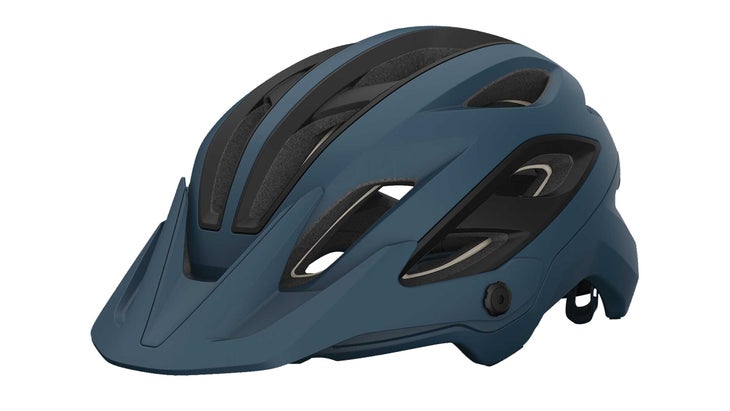
Best Overall Mountain Bike Helmet
Giro Merit Spherical
from $110 at Backcountry from $110 at Competitive Cyclist
Weight: 360 g
Size Range: S-L
Pros and Cons
⊕ Comfortable fit
⊕ Adjustable visor
⊗ Price
The Giro Merit Spherical is a pleasant visual throwback: it’s got all the tech of Giro’s Spherical design powered by MIPs technology to reduce rotational impacts, but without the particular sci-fi look of their top shelf Manifest helmet. Our top priorities in a helmet are high-end comfort and safety features, and the Merit is the ideal blend of both.
Testers found that the wind tunnel vents circulated plenty of fresh, cooling air on the steeper climbs. Additionally, the thoughtful gripper rubber bits helped us keep glasses and goggles securely in place. Last, the Roc Loc fit system keeps the Merit snug with an easy to use dial. “I really enjoyed how the Merit clung to my skull without any pressure points,” commented one tester.
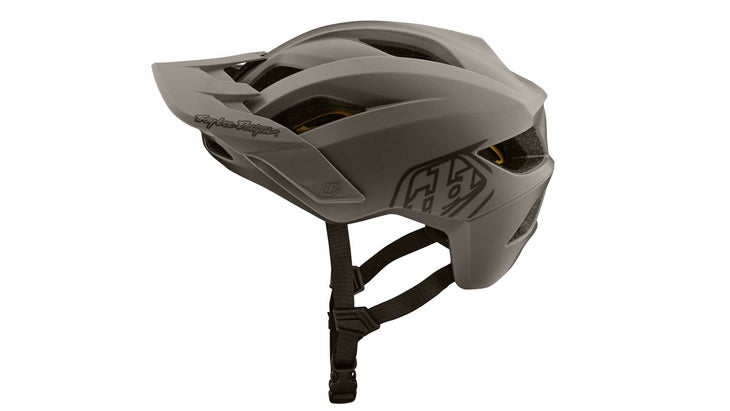
Best Value Mountain Bike Helmet
Troy Lee Designs Flowline
from $72 at Backcountry from $60 at Amazon
Weight: 320 g
Size Range: Youth, XS/S-XL/2XL
Pros and Cons
⊕ Comfortable fit with extended rear coverage
⊕ Wide range of color options
⊗ Middle-of-the-road ventilation
⊗ Big profile on small heads
The Flowline is a newer entry-point helmet from Troy Lee Designs that impressed us with its reasonable price and plethora of features. The helmet includes a MIPS B32 liner, an adjustable, three-position visor, a Fidlock magnetic buckle, and a Five star Virginia Tech Rating (including the e-bike standard).
The helmet has deep coverage and a cushy liner for maximum comfort with a retention dial that was easy to adjust on the fly. Airflow was not quite up to par with the Giro Merit or Fox Racing Speedframe helmets, but it was was sufficient enough for our testers on warm days.
While the A3 remains the top-tier Troy Lee Designs helmet, riders will find the price point and overall features of the Flowline more than satisfactory.“The Flowline carries on the tradition of comfort that the A1 kicked off when it debuted a decade ago. The price and weight are all reasonable, and the wide variety of color options makes it easy to find the ideal match for a rider’s tastes,” said Pinkbike managing tech editor Mike Kazimer.
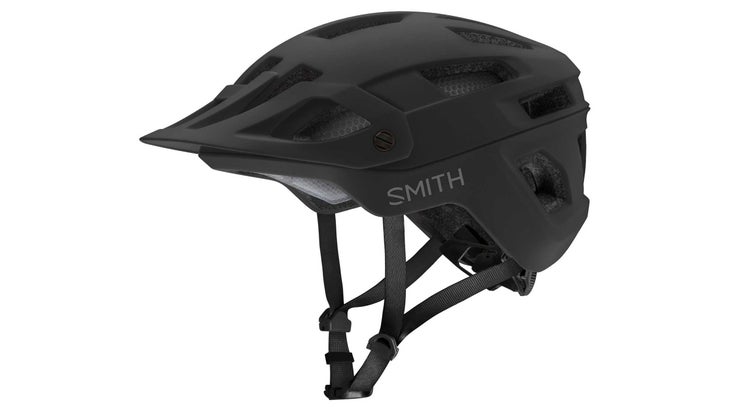
Best Fitting Mountain Bike Helmet
Smith Engage MIPS
$130 at REI $130 at Backcountry
Weight: 350 g
Size Range: S-XL
Pros and Cons
⊕ Integrated glasses holder
⊕ Sleek design
⊗ Adjustable visor isn’t really that adjustable
⊗ Not as breathable as the top shelf Forefront 2
First things first: the Engage MIPS helmet is a steal. No, it’s not as well ventilated as some premium options, and the two-position visor is a bit simplistic. But testers found that the über-comfortable fit is next level. Plus, it stayed put no matter how rowdy the trail was thanks to an easy spin of Smith’s adjustment dial in the back.
No, the helmet doesn’t have Koroyd’s energy absorption technology throughout the entire structure, but it’s present where it matters most: the forehead and temples. That, combined with the extended coverage, kept us confident and focused no matter how aggressive the trail became.
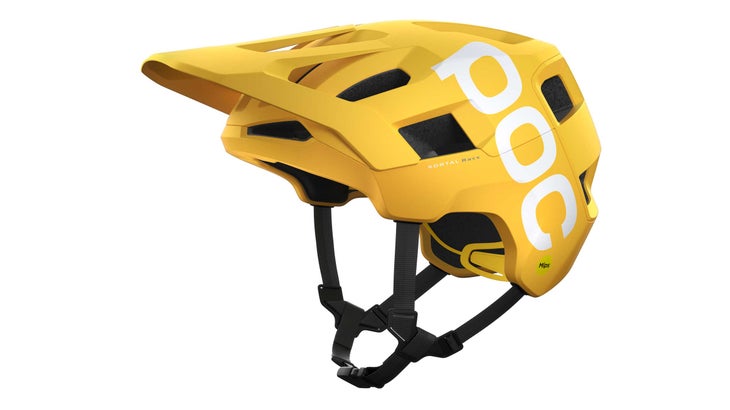
Best Protection
POC Kortal Race MIPS
from $150 at Backcountry from $123 at Amazon
Weight: 390 g
Size Range: XS/S-XL/XXL
Pros and Cons
⊕ All the key safety features, plus more
⊕ E-bike rated safety certification
⊗ Expensive
The Kortal Race MIPS helmet is one of the most protective half-shell helmets on the market, and testers felt exceptionally safe while riding with it on. It meets the usual safety certifications along with the new e-bike standard certification as well. It has extended coverage on the back of the head and temples, plus high-end safety technology like Integra, RECCO, and an EPS liner.
Testers appreciated the excellent ventilation and an easily adjustable visor on sunny test rides in Hood River, Oregon last fall. If you like to wear goggles with your helmet, POC specifically designed the Kortal Race MIPS so that the strap won’t cover any ventilation holes.
Testers found that this helmet best fits an oval-shaped head and does not integrate well with other brands of riding glasses that aren’t POC. While the price tag is a little steep, you will be paying for the most up-to-date safety features and also look stylish out on the trails.
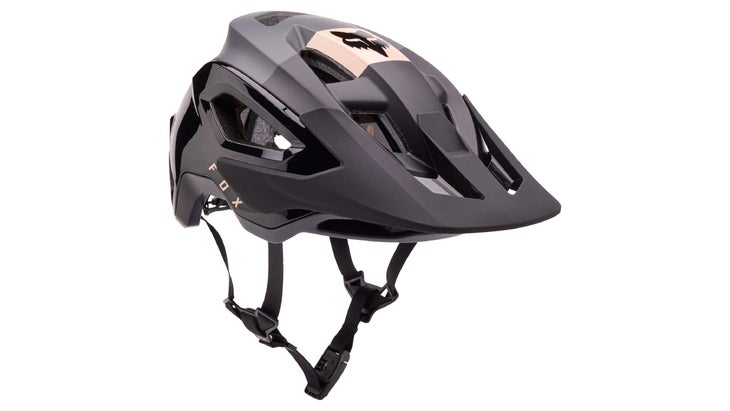
Best Mountain Bike Helmet for Large Heads
Fox Racing Speedframe Pro
$190 at REI from $108 at Backcountry
Weight: 401 g
Size Range: S-L
Pros and Cons
⊕ Decent ventilation
⊕ Removable and adjustable visor with three positions
⊗ No storage for glasses
⊗ Does not integrate well with large frame riding glasses
Fox’s Speedframe Pro is another top-tier half-shell mountain bike helmet packed with market-leading safety features. This MIPs-equipped lid has a five star Virginia tech rating, a 3-position visor, a 360-degree Fit system, and offers exacting comfort optimized for a wide range of trail riders.
“It’s a light, well-ventilated helmet that offers excellent comfort, good visibility and tends to fit a larger head,” noted one tester. The helmet is also quite long from front to back and fit our testers with oval-shaped heads best. Fit aside, the Speedframe is slightly heavier than all the other options, but 20 grams wasn’t enough of a dealbreaker for our testers.

Best Overall Road Helmet
Lazer Z1 KinetiCore
$280 at REI $280 at Backcountry
Weight: 220 g
Size Range: S-L
Pros and Cons
⊕ Lightweight
⊕ Good ventilation
⊗ Inconsistent fit
An early adopter of protective headgear in cycling, Lazer has a proven track record of thoughtful designs. The latest update to their flagship Z1 helmet incorporates KinetiCore technology—strategically placed crumple zones made up of foam blocks that divert both direct and rotational energy away from a rider’s head in the event of a crash. While KinetiCore was initially released early in 2022, the latest update to the Z1 finally brings technology to a high-performance, 220-gram helmet.
We put in over 2,500 miles with the Z1, including a week-long block of riding around the rolling hills and gravel farm roads in Northern California; it soon became a go-to for warm-weather riding thanks to 31 strategically placed vents that make it feel particularly light and airy.
However, the retention system was hit or miss for our test riders, with some commenting they couldn’t achieve sufficient tightness, while others found the slightly oval mold of the helmet fit just right.
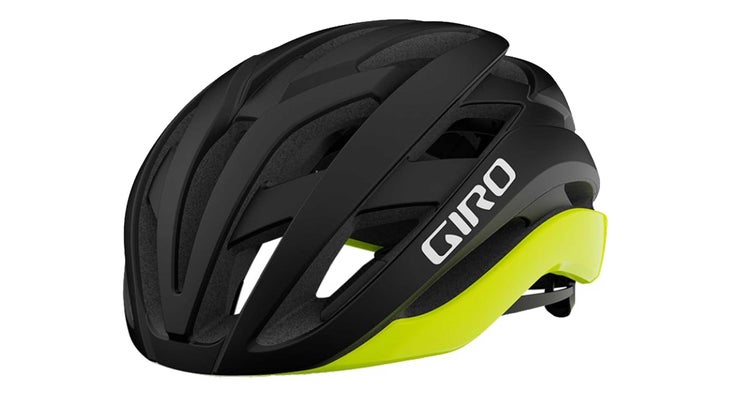
Best Value Road/Gravel Helmet
Giro Cielo MIPS
$200 at Backcountry $200 at Amazon
Weight: 305 g
Size Range: S-L
Pros and Cons
⊕ Solid cooling
⊕ Fair price for feature set
⊗ Lack of padding on retention claw
Giro has made a name for itself by pushing the limits of safety, comfort, and style since it released the first-ever EPS-foam helmet, the Prolite, in 1986. The Cielo is the latest helmet to join Giro’s storied catalog, and it does so with a superb mix of value and performance.
At just 305 grams, the Cielo offers a solid weight-to-cost ratio with its $200 price tag. Twenty-two vents provide ample cooling, and smart eyewear docking holds glasses steady. We knocked out just shy of 1,000 miles with the Cielo and were pleased with the ventilation performance on warm days.
Some of our testers complained about the lack of padding on the retention system, but the plastic surface didn’t bother most. Equipped with the MIPS Evolve Core rotation management system, the Cielo checks all the safety and function boxes we look for in a helmet.
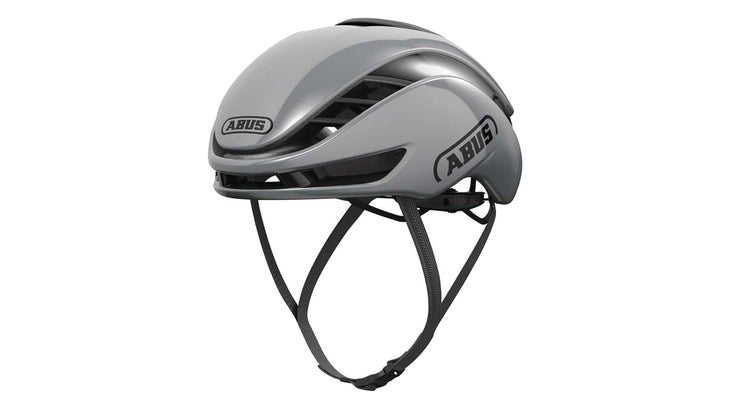
Lowest Profile Aero Helmet
Abus Gamechanger 2.0
Weight: 295 g
Size Range: S-L
Pros and Cons
⊕ Low-profile
⊗ Poor eyewear docking
Aero helmets have come a long way over the last ten years, and the Abus Gamechanger 2.0 is an excellent example. While the success of its predecessor in the WorldTour and Unbound 200 gravel race speaks for itself, the Gamechanger 2.0 has been updated with a slew of improvements, including the new MIPS Air Node system, which is thinner and less noticeable than the original MIPS.
At 295 grams, it’s lighter than most other aero helmets and explains the $300 price tag. During long five-hour-plus days of road and gravel riding, we noted impressive airflow thanks to a newly added frontal vent. Abus describes the mold of the helmet as low-profile with a more oval than round shape, which we found to be true.
One ding: Our testers noted some trouble fitting sunglasses into the intended eyewear docks, though this is a common issue across the subcategory. Also available with MIPS for $330.
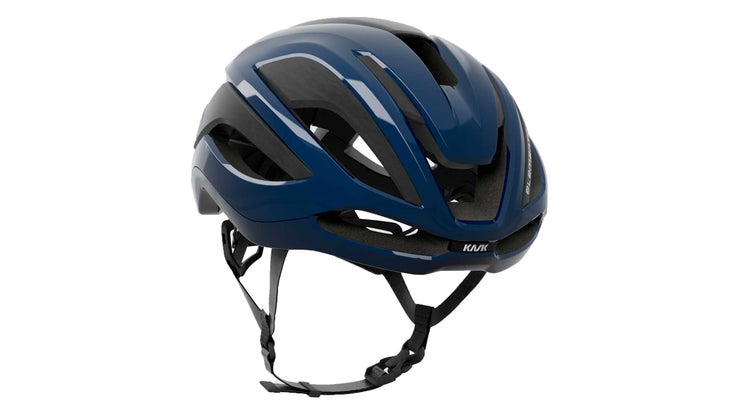
Most Luxurious Road/Gravel Helmet
Kask Elemento
$400 at Backcountry $400 at Amazon
Weight: 260 g
Size Range: S-M
Pros and Cons
⊕ Breathable design
⊕ Thick padding
⊗ Crazy expensive
The “Made in Italy” label is synonymous with quality craftsmanship and luxurious design, which is no better exemplified in the helmet world than by Kask. The Elemento impressed us with its premium feature set, including 3D-printed central padding and thick, airy forehead padding.
Worth noting: We found that the glue holding the 3D-printed padding in place lost its effectiveness after a few months of use, which was a letdown for a $400 helmet. However, the helmet’s superior performance had us taping the padding back into place and riding on.
At the Tour de Tucson, a four-hour day which saw a 30-degree temperature change between the start and the finish, the Elemento kept us cool with above-average airflow and a comfortable, lightweight fit. Kask’s retention system underwent a redesign to better accommodate riders with longer hair and got the thumbs up from our testers. The Elemento tips the scales at 260 grams, which is on the higher side of aero helmets, but not by much.
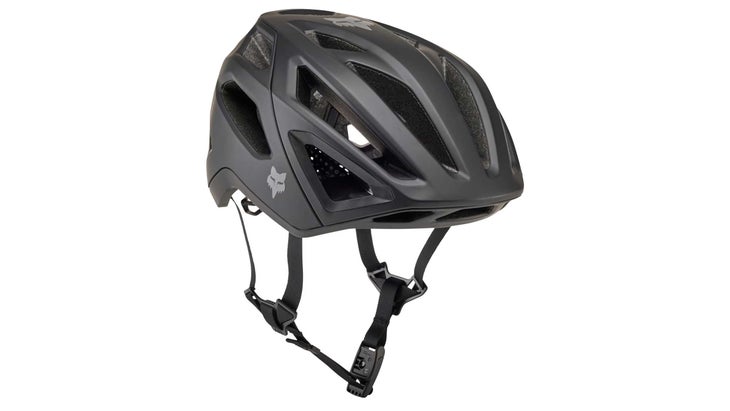
Best Gravel Helmet
Fox Crossframe Pro
from $176 at Backcountry $220 at Amazon
Weight: 355 g
Size Range: S-L
Pros and Cons
⊕ Extra protection for off-road riding
⊗ Not well-vented
Fox might not be a familiar name in the drop-bar world since the California-based brand is best known for its visor-clad, full-face mountain bike offerings. But Fox is now entering the gravel world with the Crossframe Pro, its first visorless helmet directed toward gravel and cross-country riders.
While it may be better suited toward Fox’s loyal XC contingent, there are plenty of features that transfer over for more aggressive gravel riders: a magnetic Fidlock strap and an easy-to-adjust Boa system make dialing in the proper fit simple, and TPU eyewear docking offers grip to hold your glasses in place.
At 355 grams, the Crossframe is on the heavier side of the spectrum, but much of the weight comes from the added coverage of the rear shell. One complaint was that despite all of the vents, airflow was minimal, leaving much to be desired in terms of heat dissipation on warmer days. This is more of a problem on slow, steep gravel climbs, but the trade-off may be worth it for those looking for added protection.
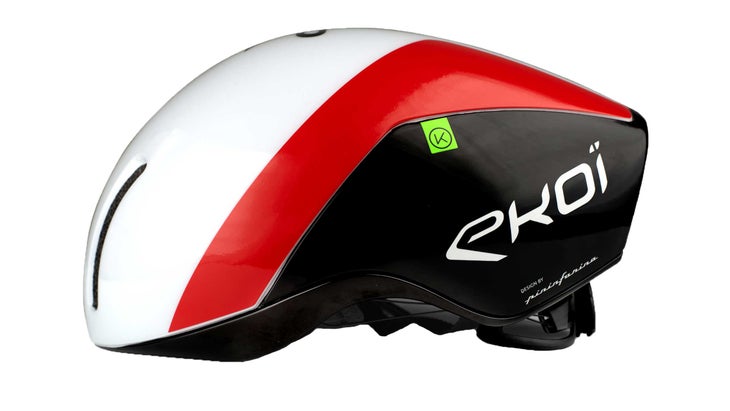
Most Euro Road Helmet
Ekoi Aerodinamica
Weight: 320 g
Size Range: S-L
Pros and Cons
⊕ Deep channels to promote airflow
⊗ Bigger-profile
Since 2001, little-known Ekoi, a France-based direct-to-consumer brand, has gained traction for its competitive prices and performance. Using its multiple partners in the professional peloton along with Italian design house Pininfarina, Ekoi developed the Aerodinamica. The French- Italian collab is just so Euro, we couldn’t resist testing it.
Koroyd, a honeycomb structure, is used throughout the EPS shell to reduce impact forces to the rider’s head in a shearing manner similar to MIPS. On the scales, the Aerodinamica hit 320 grams, which makes it a bit heavier than other aero options, but not so heavy that it’s a deal-breaker. Three forward-facing vents are paired with internal channels that promote airflow in and out of the helmet for adequate cooling. This, in turn, raises the helmet, giving it a more bulbous profile.
During a long 80-mile day climbing and cruising through the canyons of California’s Santa Monica Mountains, we were impressed with the helmet’s overall ventilation even on slow, steep slogs. At $355, the helmet is on the pricier side, but Ekoi often runs sales, and we’ve seen it listed below $250.
Bike Helmet Buying Advice
Buy New
Rule number one when buying a new bike helmet? Don’t buy used, no matter how “lightly-used” the previous owner is claiming it to be. You just never know if one minor crash or hit to the pavement compromised the helmet to the point where it’s not safe to wear anymore.
Consider Use Case and Features
Consider the type of terrain you’ll be biking on to help you prioritize which features you need. Will you be doing a lot of uphill? Make sure your helmet of choice has enough ventilation; one trend we’re fans of is the use of internal channeling to promote airflow. Other premium features to look for: a compatible spot to hold your eyewear when not in use, and a magnetic buckle. If you’re planning to bomb laps at the bike park, you might want to opt for a full-face helmet. If you’re still not sure which type and fit is the best for you, head to your local bike shop and they’ll point you in the right direction.
Budget vs. Safety Considerations
How much is your head worth? At first glance, a two-hundred-dollar price tag might seem excessive, but once you’re riding regularly, you’ll realize a quality helmet is worth every penny.
Across all categories (road, gravel, and mountain biking), we primarily considered fully-featured helmets that come with industry-leading protection technology, such as Mips. Many modern helmets use a rotational impact reduction system like Mips to dissipate the forces applied to the rider’s head during a crash. We believe that helmets featuring Mips or comparable impact protection, while pricier, are a worthy investment because they tend to offer better protection in the event of a crash.
What Are Aerodynamic (Aka “Aero”) Helmets?
Modern cycling helmets come in two general categories: traditional multi-vent designs and more optimized aerodynamic options. Traditional shells provide many vents to promote heat dissipation and a low weight. Aero helmets emphasize aerodynamic properties, often with minimal ventilation. While the aero designs are becoming more mainstream, they still remain a subcategory to lightweight, breathable, high-performance lids.
Sizing and Fit
Consider your head shape when looking for a helmet and try before you buy. Most helmets are designed with either an oval or a round shell. Your local bike shop will have a selection available and a knowledgeable staff to help point you in the right direction.
How We Test
- Number of products tested: 20
- Number of Testers: 9
- Number of miles collectively ridden during testing: 11,000
- Biggest ride: 102 miles
Our group of testers put 20 of the year’s newest road, gravel, and mountain biking helmets to the test on various rides, races, and training schedules. Some testers assessed a helmet’s performance while preparing for marquee road and gravel events, while our mountain bikers pedaled Oregon’s infamous Hood River trails. We graded each helmet we tested on characteristics like ventilation, aesthetics, weight, comfort, and functionality. The helmets on this list impressed our crew in all departments.
Meet Our Lead Testers
David Kennedy has been riding road and gravel bikes for 15 years and has been writing about the latest tech in the sport since 2017. He’s toed the line at premier road and gravel events nationwide, like the Belgian Waffle Ride San Diego and the Unbound 200. When he’s not writing or riding, he’s pulling apart bikes at his local shop and connecting with the diverse cycling community around his hometown of Los Angeles, California.
Nikki Rohan has been mountain biking for close to 20 years, and testing mountain biking gear for Pinkbike for almost a decade. She resides in Hood River, Oregon with her husband, three kids, two dogs, and a grumpy cat. She spent a chunk of time competing in the pro women category in enduro races in the PNW, as well as events like Trans BC, Trans Provence, Downieville Classic, Grinduro and the occasional CX or gravel race. When she is not working, cooking, or parenting, you will find her on the local trails or exploring the endless forest roads.
